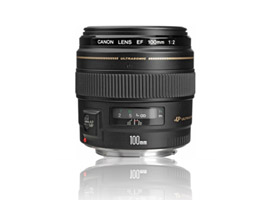Introduction
Strengths of the Canon EF 100mm f/2 USM include:
- Good resolution, perfect for photographers looking to earn income by taking portraits, or shooting weddings.
- Its brightness, with the lens measuring a transmission score of 2.2 T-stop. This makes the lens incredibly attractive for low light environments, but also for photographers wanting to snap pictures with a very shallow depth of field.
- Its excellent control of chromatic aberration.
- Limited distortion, with the defect remaining absent in most circumstances.
- Good control of lens shading and vignetting.
The camera’s one weakness is the absence of stabilization technology, making it more vulnerable and susceptible to mobtion blur. Photographers will need a steady hand, especially when shooting at low speeds.
Canon EF 100mm f/2 USM vs. Canon EF 85mm f/1.8 USM mounted on a Canon EOS 5D Mark II
The Canon EF 100mm f/2 USM looks remarkably similar to the Canon EF 85mm f/1.8 USM. Both are black, lightweight and compact, and affordable – the EF 85mm f/1.8 USM is priced at around $380 (USD), and the EF 100mm f/2 USM costs about $440.
The two even have similar lens performances. The duo produce minimal image distortion, control chromatic aberration and vignetting, and they’re both ideal candidates for working in low light conditions. But don’t let appearances or their similar image performances fool you, these two lenses have a few distinguishing differences.
Limiting resolution map in the image field at selected focal length and aperture

What separates the two can be found in their resolution. The EF 85mm f/1.8 USM’s resolution of 66 lp/mm spanked the EF 100mm f/2 USM’s already solid sharpness rating of 59 lp/mm. The EF 85mm f/1.8 USM’s resolution is impressive in that its sharpness is applied beyond the center of an image and into the corners and edges, especially at middle apertures like f/5.6.
Canon EF 100mm f/2 USM vs. Carl Zeiss Makro-Planar T 100mm f/2 ZE Canon vs. Sigma 105mm f/2.8 ED DG OS HSM Canon mounted on Canon EOS 5D Mark II
German-based optics company Carl Zeiss AG and Japanese manufacturer Sigma are prolific makers of lenses that compete with Canon’s vast selection of lenses. The two rivals have products that are in direct competition to the EF 100mm f/2 USM.
The sleek, but expensive ($1,840) Carl Zeiss Makro-Planar T 100mm f/2 ZE for Canon has strikingly similar image quality results to the Canon EF 100mm f/2 USM: both are bright, have identical resolution scores, and similar control of chromatic aberration and vignetting. The lenses big differences rest with their mechanics. Like most of the Carl Zeiss Z-series of lenses, the 100mm f/2 ZE only has manual focus. On the upside, its macro capabilities give photographers the flexibility of a portrait lens combined with the added benefit of taking incredible macro-oriented detail shots.
Sigma’s 105mm f/2.8 EX DG OS HSM, costing $970, also received high image quality grades for its ability to keep distortion, vignetting, and chromatic aberration in check. Other big perks of Sigma’s 105mm include:
- Its slightly stronger resolution, 61 lp/mm, compared to Carl Zeiss’s macro 100mm f/2 ZE and Canon’s EF 100mm f/2 USM resolution score of 59 lp/mm.
- Its stabilization system, which will help limit motion blur for photographers shoot in fast-paced environments like a basketball game.
The lens’ one weak point, at least compared to its Canon and Carl Zeiss equivalents, is that it is not as bright. Its transmission score of 3 T-stops, while good, cannot compete with the Canon EF 100mm f/2 USM’s 2.2 T-stops and the Carl Zeiss Makro-Planar T 100mm f/2 ZE’s 2.3 T-stops.
The Canon EF 100mm f/2 USM proved its hype during DxOMark testing – capable of producing images with strong resolution and limited defects – making it one of the best performing lenses in its class. Costing under $500, it is also one of the most affordable portrait lenses. Its price and strong image quality production make it an extremely good value, and difficult for other lenses to compete with.








DXOMARK encourages its readers to share comments on the articles. To read or post comments, Disqus cookies are required. Change your Cookies Preferences and read more about our Comment Policy.